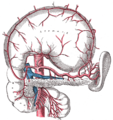Left gastric artery
| Left gastric artery | |
|---|---|
 The left gastric artery and other branches of the celiac artery (stomach in situ). Left gastric artery identified near lesser curvature. | |
 Left gastric artery is at #2 -- the upper of the two arrows. | |
| Details | |
| Source | Celiac artery |
| Identifiers | |
| Latin | arteria gastrica sinistra |
| TA98 | A12.2.12.013 |
| TA2 | 4212 |
| FMA | 14768 |
| Anatomical terminology | |
In human anatomy, the left gastric artery arises from the celiac artery and runs along[1] the superior portion of[citation needed] the lesser curvature of the stomach before anastomosing with the right gastric artery (which runs right to left[citation needed]). It also issues esophageal branches[1] that supply lower esophagus and ascend through the esophageal hiatus to form anastomoses with the esophageal branches of thoracic part of aorta.[citation needed]
Anatomy
[edit]Origin
[edit]The LGA usually arises from (the superior aspect of) the coeliac trunk - sometimes as a terminal branch of a trifurcation, and more rarely as a side branch of the splenic artery or of common hepatic artery. Sometimes it originates directly from aorta or from arteria phrenica inferior.[2]
Course
[edit]From the crus of diaphragm, the LGA arches obliquely anterior-ward and to the left to reach the left curvature of the stomach just inferior to the gastric cardia (thus erecting the gastropancreatic (peritoneal) fold).[2]
Fate
[edit]Upon reaching the cardia, the LGA splits into two terminal branches - a ventral one and a dorsal one - which anastomose with corresponding terminal branches of the right gastric artery, together providing arterial supply to the lesser curvature of the stomach.[2]
Branches
[edit]Besides its terminal ventral branch and dorsal branch, the LGA yields multiple side branches: the left lateral hepatic artery, posterior esophageal artery, anterior esophagocardiotuberous artery, branches to lymph nodes, and omental branches.[2]
Clinical significance
[edit]In terms of disease, the left gastric artery may be involved in peptic ulcer disease: if an ulcer erodes through the stomach mucosa into a branch of the artery, this can cause massive blood loss into the stomach, which may result in such symptoms as hematemesis or melaena.
Additional images
[edit]-
Blood supply to the stomach: left and right gastric artery, left and right gastro-omental artery and short gastric artery.[3]
-
The celiac artery and its branches; the stomach has been raised and the peritoneum removed.
-
Arteries and veins around the pancreas and spleen.
References
[edit]- ^ a b Lung, Kirsten; Lui, Forshing (2022), "Anatomy, Abdomen and Pelvis, Arteries", StatPearls, Treasure Island (FL): StatPearls Publishing, PMID 30247834, retrieved 2023-01-14
- ^ a b c d "Artère gastrique gauche - Dictionnaire médical de l'Académie de Médecine". www.academie-medecine.fr. Retrieved 2024-05-09.
- ^ Essential Clinical Anatomy. K.L. Moore & A.M. Agur. Lippincott, 2 ed. 2002. Page 150
External links
[edit]- Anatomy photo:38:01-0103 at the SUNY Downstate Medical Center - "Stomach, Spleen and Liver: The Right and Left Gastric Artery"
- Cross section image: pembody/body8a—Plastination Laboratory at the Medical University of Vienna
- celiactrunk at The Anatomy Lesson by Wesley Norman (Georgetown University)
- Branching at uhrad.com


